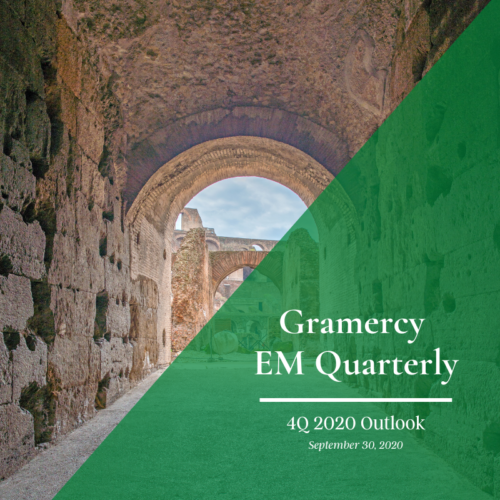Authored by:
- Robert Koenigsberger, Managing Partner & Chief Investment Officer
- Mohamed A. El-Erian, Chair
- Petar Atanasov, Senior Vice President & Co-Head of Sovereign Research
- Kathryn Exum, Senior Vice President & Co-Head of Sovereign Research
October 1, 2020
Decoding the Global Macro Environment: A Top-down Perspective and the Related Implications for Emerging Markets heading into 4Q
Encouraging signs of a V-shaped recovery for the global economy gave way during the third quarter to concerns about a more uneven, uncertain and unsettled process. With the notable exception of China and a handful of other countries in Asia and Africa, most of the global economy now faces a higher risk of seeing the recovery proceed at a pace that is slower than what is needed and what is possible.
Two main factors have contributed to the slower and more uneven pace of the global economic recovery.
First, rising infections in Europe, in particular, have highlighted the risk of a “second wave” of the COVID-19 virus. While this higher infection rate has fortunately not translated – at least for now – into the level of tragic hospitalization and deaths experienced during the first wave, the phenomenon is worrisome enough to lead a number of countries to reverse the prior re-opening measures. This has reduced the ability of some people to engage in greater economic activity. Meanwhile, the willingness to do so has been undermined by the associated increase in health-related “human counter-party risk,” both real and perceived perception. Together the two have contributed to slowing high frequency economic indicators as well as a leveling off in other more traditional economic measures, including the weekly initial jobless claims in the United States.
The health situation remains more worrisome in much of Latin America and India. Here, despite concern about infection rates, governments have been more hesitant about imposing new restrictions. In fact, some have gone forward with re-openings including India where the latest relaxation of restrictions coincided with an increase in daily infections to a world record setting level of 90,000. With less economic and financial resilience, these governments fear that such restrictions would cause more damaging economic devastation, highlighting a particular acute health-economic nexus as the world iterates to finding ways to “live with COVID-19.”
The second factor relates to economic policy. Having reacted in a bold and impressive way at the start of the COVID-19 shock – one governed by an “all in,” “whatever it takes,” and “whole of government” approach – the ability to do this repeatedly has eroded when it comes to fiscal action and structural reforms. In some countries, like the United States, it has been a political issue with the two parties there finding it hard to compromise on a Congressional relief package. In some other countries, particularly in the emerging world, it is more related to shrinking policy space.
With a more hesitant fiscal response and slowing economic activity in much of the world, systemically-important central banks have felt that – once again – they had no choice but to do even more. The quarter saw the Federal Reserve, in particular, expand its uber-hawkish forward guidance, packaged this time around in a revision of the monetary policy framework that allows policymakers to run the economy hotter for longer. Yet the further it ventures in this, the greater the risk to its policy effectiveness and creditability.
Together, all this has led to a mixed environment for emerging economies.
A less buoyant global recovery and the return of health-related restrictions translate into a smaller global impetus for their own economic recovery – be in through less dynamic demand for their exports, curtailed tourism earnings and/or low inflows of worker remittances. But even more lax financial conditions in Europe and the United States have continued to push financial flows to the emerging world, albeit in a less consistent manner in September, as investors look to generate higher returns confident that central banks have their back covered.
This mix has proven particularly acute for those investing in less resilient opportunities in emerging markets, be they sovereigns, quasi-sovereigns or corporates. On the one hand, lax global financial conditions overall continued to support asset prices in a self-reinforcing momentum cycle that drives certain valuations ever higher and risk spreads ever lower. On the other hand, these valuations became even more disconnected from what fundamentals could reasonably expect to validate over time. Indeed, if anything, these fundamentals pointed to a growing risk of a paradigm of non-payment for particularly weak credits.
This dilemma has been long in the making, increasingly risking to separate tactical investment considerations from strategic ones and contrasting even more fundamentals with liquidity technicals – particularly in market segments, such as emerging markets, not directly under the umbrella of the asset purchase programs of systemically-important central banks. It became even more pronounced in September as some parts of the marketplace started to question the long-standing faith in the effectiveness of loose monetary policy, thereby also bringing to fore other uncertainties (including those relating to the U.S. elections, China-U.S. tensions, Brexit, etc.) that deep liquidity conditioning had totally sidelined.
Main Themes Influencing Investment Decisions in 4Q
Global economic recovery set to slow down in 4Q
Global economic developments during the third quarter validated the expectations we laid out in our 3Q outlook: astonishing contractions in 2Q across both emerging markets (EM) and developed markets (DM), followed by a strong rebound in economic activity from a low base. The recovery was supported by ubiquitous policy stimulus and the gradual lifting of restrictive measures that authorities around the globe imposed in the second quarter to slow the spread of COVID-19.
Given the sudden stop in economic activity during 2Q, the quarter was one of the worst on record for most global economies and now we have a better handle on the massive scale of the fallout. Among major EMs having reported data, the most significant GDP contractions took place in Peru (-30.2% YoY), India (-23.9%), and Mexico (-18.9%). Outside of China (+3.2%), the best performers were Indonesia and Russia whose economies contracted by “only” 5.3% and 8.5%, respectively (see Exhibit 1). In DM, the UK (-21.7%) and France (-18.9%) experienced the worst declines, while the U.S. (-9.1%) and Japan (-9.9%) fared relatively better.

With the 2Q deep economic contraction as the backdrop, most global PMIs and other forward-looking indicators staged an impressive recovery during the third quarter, signaling a decent rebound in 3Q growth and prompting upward revisions to overall 2020 GDP projections for many economies. This being said, after the impressive reading in July, softer PMI prints for August and (preliminary) September (Exhibit 2a) in the Eurozone indicate that the recovery has been losing momentum.
Most likely, this reflects the resurgence of COVID-19 cases in many parts of Europe having a dampening effect on economic activity/sentiment, especially in the services sector that drove the moderation of the recovery. Among major EMs, Russia, Brazil and Indonesia PMIs showed a strong recovery during 3Q (see Exhibit 2b). However, given that Western European countries tend to be a few weeks ahead of the Americas and Eastern Europe in terms of the virus lifecycle, we are concerned that a number of EM jurisdictions could face their own challenges to economic recovery in 4Q related to COVID-19 re-acceleration.
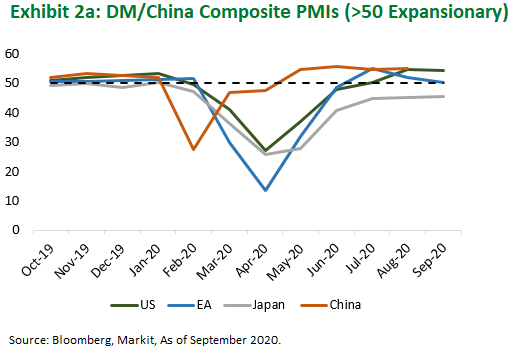
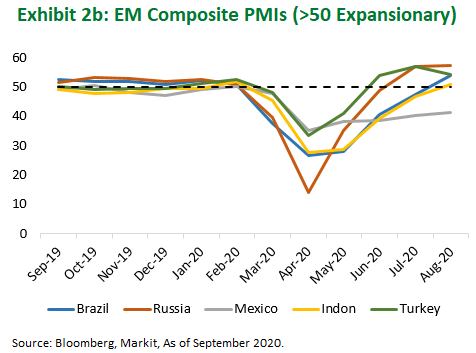
In that context, as we enter the last quarter of a tumultuous 2020, the global economic recovery is facing a number of serious tests and we expect to see a flattening out in growth momentum. The “low hanging fruit” of the recovery is now behind us and we think the road ahead in the last quarter of the year will be tougher for the global economy. Importantly, the “ammunition” used by many governments to continue supporting the recovery might no longer be as robust due to policy space constraints and complicated political contexts. Furthermore, in a “multiple round” as opposed to a “one round” game, the design of delivering massive policy support becomes trickier, in our view.
The main downside risks on the horizon that can test the resilience of the ongoing economic recovery are a potential material “second wave” of the pandemic during the fall and winter months in the northern hemisphere and the possibility of a contested U.S. Presidential Election without conclusive results for at least several weeks after November 3rd. A lack of clarity on policy direction by the world’s largest economy will materially elevate uncertainty and has the potential to introduce significant volatility in markets. In terms of upside risks, hope exists that an “October surprise” in the form of an approved COVID-19 vaccine might materialize, but questions around timing, effectiveness and distribution are material.
As such, the recovery in 4Q and into 2021 will mainly be a function of the willingness and ability of individuals to re-engage with the economy while a sustainable medical solution to the COVID-19 crisis remains unavailable. We define “sustainable solution” as an effective vaccine that is widely accessible on a global scale and ensures long lasting immunity with limited severe side effects. In this interim period, we think most governments/societies will opt for a “living with the virus” approach that attempts to balance the dilemma between “lives” and “livelihoods”, which is an especially acute one in many EMs that lack the social safety nets and enforcement mechanisms of their DM counterparts.
Given the behavioral aspects of “lockdown fatigue” within societies and the high economic costs, we believe governments will resort to re-imposing full lockdowns only as a last resort in scenarios where hospital systems are on the verge of being overwhelmed and mortality rates among new confirmed cases climb back to March/April levels. However, this does not mean a “return to normal”: as long as “human counterparty risk” remains substantial, many people are likely to remain cautious and limit their social and economic interactions.
Against this backdrop, tracking of consumer behavior and mobility is an important leading indicator in determining the strength and timing of economic recovery going forward. Recent data had shown a clear trend toward gradual re-engaging with economic activity, but most societies have remained below their baselines based on corresponding activity in January and February this year (see Exhibits 3a and 3b).
When looking at the Mobility and Engagement Index (MEI) for the U.S. economy compiled by the Dallas Fed, we see that after a steep recovery from April to July, mobility and engagement within the U.S. economy has plateaued. We read this as a signal that going forward, the demand-side recovery will likely face substantial headwinds as consumers behave in a risk adverse fashion even when restrictions are lifted. As such, we think that the next leg up requires a material decline in “counterparty risk”, i.e. an effective and widely available vaccine. This confirms our view that, after the likely strong rebound in global growth in 3Q, the economic recovery will get significantly tougher from here until a reliable medical solution becomes available.
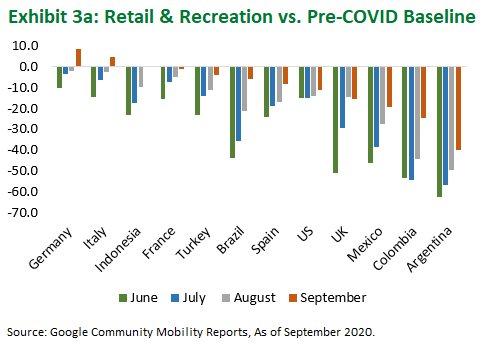
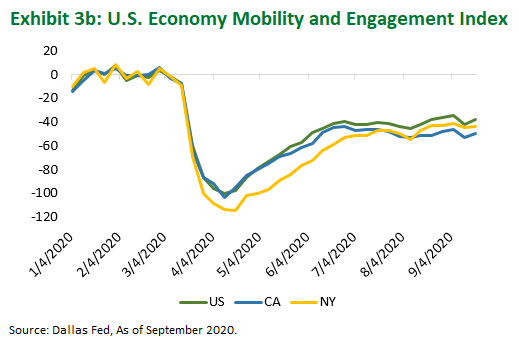
Despite a less pessimistic global outlook relative to that at the start of the third quarter, it is important for investors to keep in mind that the “V”- shaped recovery observed in most global markets is not grounded in a similar sharp recovery by global GDP. The world economy still has a long way to go to recover the output lost due to the COVID crisis. In fact, even with a less severe than initially feared contraction in the global economy this year and no material “second shock” due to renewed full lockdowns, world GDP is not projected to return to its pre-crisis level at least until the end of 2021 (see Exhibit 4).
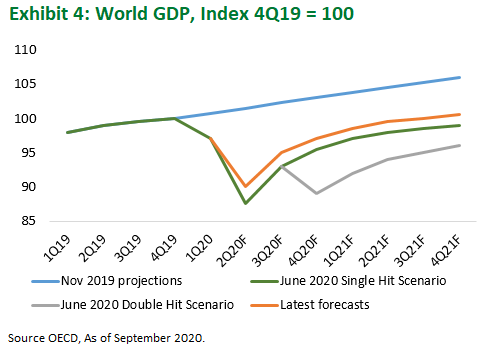
In the context of a prolonged and gradual economic recovery, country and corporate-specific variations in crisis management, resilience and structural economic conditions will drive credit differentiation, highlighting the importance for investors of granular bottom-up analysis to avoid unrecoverable mistakes and take advantage of embedded opportunities.
Continuation of strong policy support is crucial in shaping the recovery and for markets amid deteriorating fundamentals, but is becoming politically harder to deliver
As we argue in the previous section, after a better-than-expected rebound in 3Q, the global economic recovery is likely to lose momentum going forward, until an effective medical solution to the crisis becomes widely available. Although improved relative to the recent past, the outlook remains profoundly uncertain and dependent on the pandemic’s progression and people’s behaviors in reaction to it. In this context, policy choices will be crucially important to boost still weak confidence and support the global economy in its challenging journey ahead. Furthermore, sustained monetary and fiscal stimulus will be important to prevent deteriorating fundamentals from reasserting themselves in the “tug-of-war” with abundant liquidity that has come to characterize global markets since the start of the pandemic.
Thus far, policymakers across the globe have acted quickly and massively to backstop economies ad markets from the huge COVID-19 related shock. However, as governments in some DM and most EM countries did not enter the crisis with tremendous policy space available, we are concerned that any subsequent round of policy support is likely to be politically more complex. Given the high materiality for markets of global policymaker’s decisions and signaling, in 4Q and beyond we will be paying particular attention to signs that political constraints to policy support might be emerging in case of a “multi-round” stimulus game.
For now, synchronized QE by the systemic central banks in response to the COVID-19 exogenous shock remains notable and has served as a backstop to asset price deterioration. In addition, Central Bank’s (“CB”) signaling continues to be consistent with a “whatever it takes” approach. The Big Four global central banks (“G4”), i.e. the U.S. Federal Reserve (Fed), European Central Bank (ECB), Bank of Japan (BoJ) and Bank of England (BoE) have collectively increased the size of their balance sheets by 16.4% of combined GDP (see Exhibits 5a and 5b) to 52.5% in September, from 36.1% back in February.
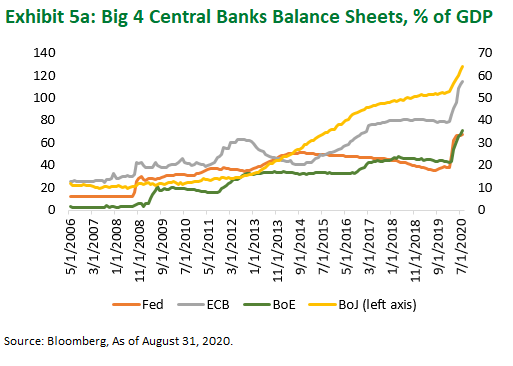
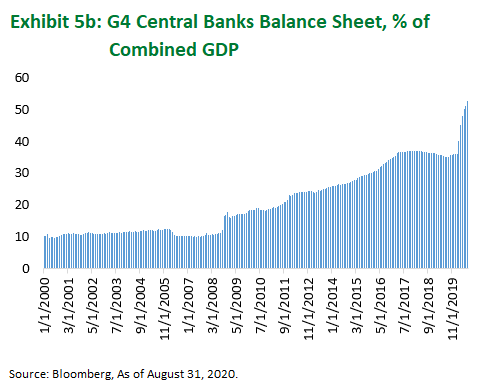
Despite the growing divide between effects on the real economy (highly uncertain) and financial markets (strongly positive thus far), the G4 CBs stand ready to provide more stimulus, if needed. In this environment, proximity to/spillover effects from the G4 CB liquidity injections have proven important for EM assets and we expect this trend to continue in the fourth quarter. Importantly, there is little doubt that policy rates and safe haven yields in DM will remain at record low (or negative) levels for the foreseeable future, increasing the attractiveness of EM hard currency assets for yield-hungry investors.
During 3Q, the Fed announced officially that it shifted to targeting “average” as opposed to “current” inflation, essentially formalizing the significant policy flexibility that it has already pursued in recent years and sending yet another “lower for longer” signal on U.S. rates. In EM, the strong rate cutting momentum that we witnessed in the early stages of the crisis has eased. However, the overall tone by EM central banks remains on the dovish side given unprecedented uncertainty and we do not expect monetary tightening in 4Q unless extreme currency weakness due to idiosyncratic factors forces it . For example, faced with significant pressures on its currency and FX reserves, in September, Turkey became the first major EM jurisdiction to tighten monetary policy since the start of the pandemic, albeit less aggressively than what markets had hoped for. In general, materially lower real rate and carry advantages for EMFX relative to historical levels explain why high yield emerging market currencies have not been able to capitalize more materially on recent USD weakness. We remain cautious and expect to remain highly opportunistic on EMFX in the fourth quarter.
Even before the COVID-19 shock, we wrote consistently on the observation that stronger and more equitable global growth necessitates targeted fiscal stimulus to complement and eventually “take the baton” from monetary policy. As we highlighted in our 3Q outlook, a material fiscal response took place in the initial phase of the crisis, especially when economies were forced to shut down and millions of workers around the globe temporary or permanently lost their income. The size of fiscal support in DM has been extraordinary and staggering (to the tune of 20-25% of GDP in some economies). While smaller in relative terms, support packages implemented by EM authorities have also been robust, reaching double digits as percentage of GDP in a number of cases.
This being said, the initial strong momentum has waned, in most cases due to obstacles linked to domestic political processes. The main example is the so-called “Phase IV” stimulus deal in the U.S. that has lost steam running into significant political hurdles and could well be delayed until after the elections in November. As such, the size and timing of any additional fiscal support (initially expected to be in the $1-1.5 trillion range) in the U.S. is uncertain and a function of the elections’ outcome; it is unlikely to materialize or have a major impact in 4Q, in our view. In other cases across both EM and DM, the effectiveness of fiscal spending on the economic and social response to the pandemic is increasingly being questioned, which leads to escalating domestic political noise, and can ultimately hurt economic/market confidence.
While fiscal policy support has been critical for backstopping the domestic economies, on the flip side, it will drive a significant deterioration in debt and fiscal metrics. As such, its effectiveness in supporting economic activity and the authorities’ ability to implement fiscal consolidation after the emergency has passed will be a key driver of relative credit quality in EM going forward. Fiscal deficits and debt burdens in EM will increase across the board in 2020, while the picture in terms of external (i.e. current account) deficits is more mixed (see Exhibits 6a and 6b). We are concerned that fiscal commitments and debt burdens for a number of EM sovereigns approach unsustainable levels and might require restructuring in the post-COVID-19 period, but we also note that others remain comfortable. The latter group entered the crisis with sufficient fiscal space to absorb the deterioration and will emerge on the other side of the pandemic in an even stronger relative credit position in relation to their peers. In that context, “credit resilience” is the key theme that we expect to emphasize in our portfolios in 4Q and beyond.
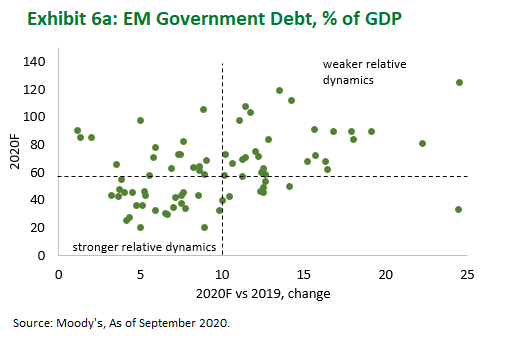
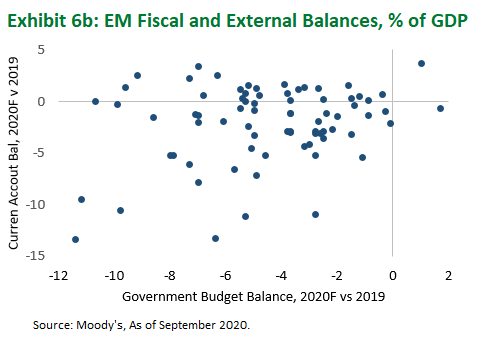
Political risks and geopolitical uncertainty back to center-stage: U.S. elections and U.S.- China tensions
In the fourth quarter, risk markets will be subject to elevated political risks stemming especially from the U.S. Presidential and Congressional elections in November. We believe caution is warranted given the extraordinary environment in the midst of a global pandemic and the non-negligible probability that the results will be contested and legally challenged. Given that a large number of voters will be casting their ballots by mail, final tallies in many states will not be available for at least a few days after November 3, which is unpreceded in modern U.S. history and carries a number of risk scenarios. Investors need to be prepared that instead of an “election day”, markets will face at least an “election week” in November.
Moreover, if polls tighten and indicate that Electoral College results will be close, legal challenges appear very likely and the base case may shift to an “election month”, which is a scenario that also carries risks of civil unrest and will materially elevate uncertainty for global markets. In addition, the recent passing of Supreme Court Justice Ruth Bader Ginsburg has created a vacancy on the Court that is very likely to become a centerpiece of the 2020 presidential campaign. If during 4Q, President Trump and Senate republicans are successful in installing a conservative replacement to Justice Ginsburg who was a reliably liberal vote in a 5-4 court divided along ideological lines, the potential for market-disruptive political turbulence in the U.S. becomes even higher.
Beyond risks surrounding the election process, markets will be focused on the actual policy priorities of the two presidential candidates and the likely outcomes depending on which party ends up controlling the Senate (there is little doubt that the Democrats will retain the House). In general, we think markets can expect a large fiscal stimulus anchored by significant funds for green infrastructure and health care systems, along with a stronger redistributive theme, under a Biden Presidency. Under a second Trump Administration, further fiscal policy support for the economy is also possible but in smaller magnitude, and instead the focus in 2021 will be on a stronger decoupling from China. Other priorities will include attracting manufacturing back to the United States, making pandemic-related immigration restrictions permanent, and extending as much of the Trump tax cuts as possible before they expire at various points over the next five years.
In the realm of foreign policy, major geopolitical shifts with tangible market impact are likely if former Vice President Biden successfully dethrones President Trump. This being said, tensions with China are set to remain high regardless of the eventual winner, in our view. However, U.S. pressure on China will likely evolve in very different directions depending on the next administration. In relative terms, less market-disruptive under Biden (i.e. human rights, environment etc.) and more disruptive for markets under a Trump second-term (trade, national security, technology etc.)
All else being equal, we expect, a more cooperative and multilateral U.S. global policy approach under Biden to benefit EM in general. However, there is a multitude of nuances for specific emerging economies, depending on their circumstances and their leaders’ relationship with President Trump.
For example, Biden’s strong environmental agenda could create challenges for Brazil and Mexico. This being said, Turkey and Saudi Arabia and, to a certain extent Russia, are the major EMs we expect will face a much tougher foreign policy approach by a Biden Administration compared to the status quo. In case of Democratic control of the Senate, material sanctions on Turkey can finally materialize, as well as new sanctions on Russia, depending on whether new election interference allegations emerge over the coming weeks/months.
U.S. support for multilateral organizations such as the IMF and the World Bank will be significantly stronger under Biden, which means that more funds will likely be available to support highly indebted EMs amid the COVID-19 emergency. Africa in particular will likely benefit from increased U.S. attention under a Biden Administration, including further G20 efforts on debt service relief and additional SDR allocations at the IMF.
Last but not least, we anticipate the relationship between the U.S. and China to remain challenged in the run-up to the U.S. election with a continued focus on areas of technological and financial decoupling. Following President Trump’s executive orders in August to ban Chinese social media applications WeChat and TikTok, we expect the U.S. Administration to move forward with additional actions against Chinese telecom equipment suppliers, software and data companies to impede China’s technology sector and preserve national security. Additionally, further steps to support domestic production and procurement of critical and essential pharmaceutical-related goods is likely along with passage of legislation that could result in eventual delisting of Chinese ADRs from U.S. exchanges. Sanctions on foreign financial institutions under the Hong Kong Autonomy Act are also possible albeit the harshest and most disruptive measures will likely be avoided.
While China has had mixed performance under the Phase One trade deal agreed upon in January, the associated market impact of a collapsed deal and snapback of sanctions could have negative election implications for President Trump. As such, we think the U.S. Administration will continue to focus on other areas of decoupling in the near term although escalation on this front cannot be completely ruled out.
Looking beyond the election, a Biden presidency would likely remain tough on China due to the bipartisan views on China’s unfair trade and investment policies, human rights violations, and threat to national security. However, his style and tactics would likely vary to that of Trump’s and should be less disruptive for EM Asian economies. Biden may adopt a more nuanced approach to trade with the possibility of selective tariff reduction and TPP participation and a broader and more diplomatic strategy on technology related issues in exchange for cooperation in other areas such as climate. His campaign plan pledges to invest $300bn in research and development in order to boost innovative capacity to compete with China, which contrasts with Trump’s narrower hardline strategy of containment. In the backdrop of a more multilateral U.S., the Chinese may be more inclined to ease its recently more aggressive geopolitical approach. In the event of a second Trump term, we expect deepening of his existing strategy, which would likely drive increased market volatility and embolden China’s ‘wolf warrior’ diplomacy.
Optimal Asset Allocation within EM In This Context
Throughout most of 3Q, EM credit strategies traded as if the rout of March 2020 never happened. That is, until recently, indices had recovered to their February highs (See Exhibit 7). This rally was driven by several factors including initial conditions (oversold) and the flood of global liquidity provided by central banks in response to the market mayhem of March 2020. Despite historically tight yields, we believe the rally was further fueled by relative value buyers looking for incremental yield pick-up despite low absolute yields. A good example of relative value trumping absolute value is illustrated in Peru 10 year bonds. Throughout most of 3Q, the bonds traded at a mere 1.5% YTM!
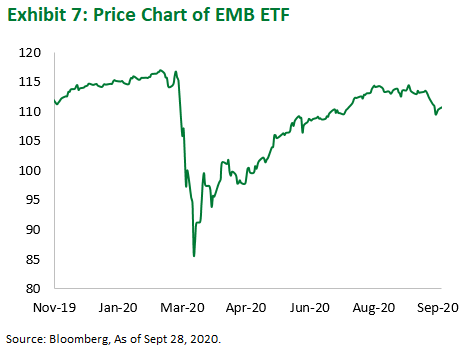
The strong rally, fueled by a recovery in flows to the asset class over the past two quarters, places emerging credit markets in a similar technical position which we highlighted late last year (See our Q1 2020 Outlook) When outflows return to the asset class, we should expect dislocation risk/opportunities to present themselves again. Once again, FOMO (Fear of Missing Out) and TINA (There is No Alternative) have forced market participants to play a game of musical chairs; waiting to see when the music to stop and then looking to de-risk their portfolios.
When we move from FOMO/TINA toward musical chairs and, potentially, a sudden stop of liquidity, we believe we will see dislocations similar to those witnessed by the market in the past. What was notable about the COVID-19 driven dislocation of 2020 is not only how fast it dislocated but also how fast it recovered.

Given current market conditions, we believe the market is fraught with dislocation risk and opportunities. However, as we suggested earlier in the year, if we are witnessing a retreat in liquidity we should expect an acceleration of additional risks and opportunities in defaults. We have discussed this in our recent white papers available here: Emerging Markets Debt Relief and the Paradigm of Non-Payment and The Coming Cycle of High Yield Defaults. Dynamic asset allocation and credit differentiation will continue to be important drivers of absolute and relative returns in this environment (See Exhibit 8).
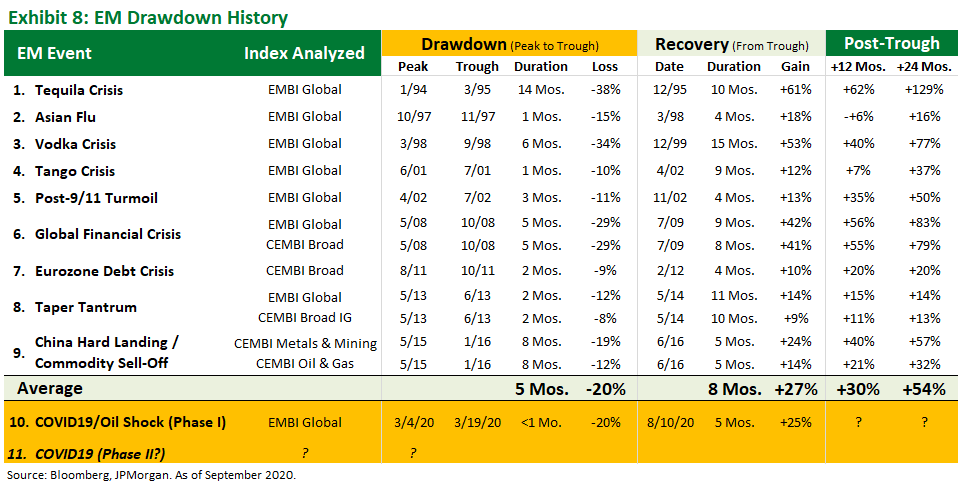
As 3Q concluded, one had to wonder if the music is stopping. All summer, investors were conditioned to buy the dip until it stopped working and then go the other way/sell. September has not been kind with a significant retreat of global markets. Only time will tell but we believe caution is warranted. As such, we are pursuing ROA; resilience, optionality and agility across the different portfolios that we manage.
We are cautious on our EMD portfolios. As the quarter comes to an end, we are expressing such caution through increasing cash, decreasing betas and relative value switches toward higher quality credits and liquidity. This barbell may underperform in the short run if the technical rally remerges but we are focused on protection against dislocation and credit risk on the near horizon. We would rather miss-out a bit than suffer any non-recoverable mistakes.

In our Alternatives strategies, we are also expressing caution through a combination of looking to monetize realized gains, increasing cash and tactically increasing hedges. At the same time, we are actively preparing/underwriting dislocation and default candidates to consider adding to our clients’ portfolios at the appropriate point. As we sort through these “Fallen Angels”, it’s important that we triage them for ILUV. That is, avoid the I’s or the credits that go down and stay down and patiently underwrite the L’s that will go down but still perform/provide carry/current yield. Further, preference the U’s that will provide carry and achieve price recovery with economic growth and the V’s that will provide carry and bounce with the return of liquidity.
In the Capital Solutions/Private Credit space, we have seen a significant retrenchment from both local and international banks across EM. This has opened up opportunities in certain areas that were previously dominated by bank financing at single digit rates such as high quality, real estate backed developments in Mexico and Peru.
More generally, the effect of the central bank-induced stimulus has led to haves and have nots within global markets, including EM. Certain issuers outside the central bank “umbrellas” have struggled to find financing alternatives. As a result, we have found there is less capital for high yield and first time issuers which has created a unique opportunity for asset-backed, private credit opportunities in EM. The collateral structures and returns are stronger than pre-COVID levels giving us the ability to remain patient and dictate more favorable terms. Lastly, we have accelerated the development of lending platforms during the COVID-19 period as arbitrage opportunities have become more attractive and compelling from a risk/reward perspective.
In Special Situations, we continue to pursue short-term lending opportunities related to COVID-19. We also continue to provide litigation finance and collection support on sovereign and corporate claims globally. Lastly, we are litigating and settling property insurance claims related to hurricane damage in Puerto Rico and Florida and looking to pursue a broader insurance claim recovery effort in the coming quarters. We believe that these types of investments remain attractive on both an absolute return basis and as an important diversifier in our multi-asset portfolios.
Across the platform we will continue seeking to build resilience in the portfolios and underwrite opportunities and pipelines now so we are prepared when they present themselves due to illiquidity or credit events. As always, we will continue to “Plan the Trade and Trade the Plan”.
In closing, we would like to again thank everyone for joining us for our inaugural Gramercy Investor Forum. We enjoyed seeing you there and hope that you all found the event to be informative and enjoyable. It is our sincere hope that you, your teams and your families remain well.
About Gramercy
Gramercy is a dedicated emerging markets investment manager based in Greenwich, CT with offices in London and Buenos Aires and dedicated lending platforms in Mexico City and Istanbul. The firm, founded in 1998, seeks to provide investors with superior risk-adjusted returns through a comprehensive approach to emerging markets supported by a transparent and robust institutional platform. Gramercy offers alternative and long-only strategies across emerging markets asset classes including multi-asset, capital solutions, private credit, distressed debt, USD and local currency, sovereign, high yield/corporate debt, and special situations. Gramercy is a Registered Investment Adviser with the SEC and a Signatory of the Principles for Responsible Investment (UNPRI). Gramercy Ltd, an affiliate, is registered with the FCA.
Contact Information:
Gramercy Funds Management LLC
20 Dayton Ave
Greenwich, CT 06830
Phone: +1 203 552 1900
www.gramercy.com
Joe Griffin
Managing Director, Business Development
+1 203 552 1928
[email protected]
Investor Relations
[email protected]
This document is for informational purposes only, is not intended for public use or distribution and is for the sole use of the recipient. It is not intended as an offer or solicitation for the purchase or sale of any financial instruments or any investment interest in any fund or as an official confirmation of any transaction. The information contained herein, including all market prices, data and other information, are not warranted as to completeness or accuracy and are subject to change without notice at the sole and absolute discretion of Gramercy. This material is not intended to provide and should not be relied upon for accounting, tax, legal advice or investment recommendations. Certain statements made in this presentation are forward-looking and are subject to risks and uncertainties. The forward-looking statements made are based on our beliefs, assumptions and expectations of future performance, taking into account information currently available to us. Actual results could differ materially from the forward-looking statements made in this presentation. When we use the words “believe,” “expect,” “anticipate,” “plan,” “will,” “intend” or other similar expressions, we are identifying forward-looking statements. These statements are based on information available to Gramercy as of the date hereof; and Gramercy’s actual results or actions could differ materially from those stated or implied, due to risks and uncertainties associated with its business. Past performance is not necessarily indicative of future results. This presentation is strictly confidential and may not be reproduced or redistributed, in whole or in part, in any form or by any means. © 2020 Gramercy Funds Management LLC. All rights reserved.
